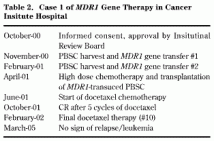Gene Therapy for Breast Cancer
MDR1 Gene Therapy in Cancer Institute Hospital
Our group also started MDR1 gene therapy for breast cancer. This study was approved by the Ministry of Health and the Ministry of Education and Science on February 24, 2000. The outline of the protocol is shown in Fig 1. We selected histologically confirmed, metastatic breast cancer patients who achieved good PR or CR to a precedent conventional dose chemotherapy regimen (using anthracycline and/or taxane). We used a HaMDR vector in which wild type MDR1 cDNA (Kyoto University) had been inserted into pHa vector (NCI) derived from Harvey mice sarcoma virus (HaMSV). Peripheral blood stem cells (PBSC) were harvested by cyclophosphamide and G-CSF.
CD34-positive cells were selected from about one third of PBSC, and HaMDR was transferred into those cells stimulated by SCF, thrombopoietin, IL-6, Flt-3 ligand, and soluble IL-6 receptor. Transduced PBSC were checked for safety (presence of replication-competent retrovirus, etc.) and then frozen. Patients were treated with high-dose cyclophosphamide, thiotepa, and carboplatin. Then unprocessed and MDR1 gene-transduced PBSC were transplanted together. After bone marrow was reconstituted and patient status was normalized, patients were treated with 50% of standard dose docetaxel, then with increased doses up to 100% if grade 4 neutropenia was not recorded .
Gene transfer efficiency and P-gp expression were checked with PCR and flowcytometry analysis, using peripheral leukocytes and bone marrow cells.
So far, two patients have finished high-dose chemotherapy, PBSC transplantation with MDR1 gene transfer, and then docetaxel chemotherapy (Table 2).
 Table 2.Case 1 of MDR1 Gene Therapy in Cancer
Table 2.Case 1 of MDR1 Gene Therapy in Cancer
Insitute Hospital Peripheral blood P-gp-positive leukocytes increased to 5% after transplantation but decreased gradually. During docetaxel chemotherapy after transplantation, in vivo expansion of the MDR1-transduced cells (up to 10%) was obser ved. Comparison of two patients suggests the presence of a bone-marrow protection effect by MDR1 expression during docetaxel chemotherapy, but this is not clear. No serious side effect was observed, and the patients have been in complete remission for 3 years.
Retroviral gene therapy causes random insertion of exogenous genes into genome DNA of target cells, so it may cause carcinogenesis by activation of oncogene or inactivation of tumor suppressor gene. At the end of 2002, occurrence of T cell leukemia in two patients after gene therapy for X- linked severe combined immune deficiency (X- SCID) was reported. A genetic defect in the ϒC gene, which is a common domain of multiple interleukin receptors (IL-2R, IL-4R, IL-7R, et al.), causes severe defects of T cell and natural killer cells as well as severe immune deficiency in X- SCID patients. Retroviral ϒC gene transfer using autologous CD34-positive hematopoietic cells in X- SCID patients restored immune system in 9 of 11 patients31). But T cell leukemia occurred in three patients (one more patient in January 2005) of those 9. In the leukemic cells, retroviral vector was inserted in the LMO2 gene, which causes T cell leukemia32). Then the FDA recommended suspension of all clinical trials of retroviral gene therapy for hematopoietic stem cells. We also suspended MDR1 gene therapy for the third patient in January 2003. After thorough investigation of retroviral gene therapy trials for hematopoietic stem cells all over the world, no leukemia event has been found in clinical gene therapy trials, other than the French X-SCID trial (American Society for Gene Therapy Annual Meeting, 2003). Screening of the Mouse Retroviral Cancer Gene database showed that retroviral insertion into ϒC and LMO2 gene was found in two cases each, and insertion into both genes were found in one case.
This fact suggests that both genes are oncogenes, and that the two genes can collaborate33). In X- SCID gene therapy, a double hit with retroviral activation of LMO2 gene and exogenous activated ϒC gene might be necessary for leukemogenesis.
If so, retroviral gene therapy with non-oncogenic genes might have a low risk of cancer34).
Thereafter, gene therapy using retroviral vector resumed, and retroviral gene transfer into hematopoietic cells of adenosine deaminase deficiency patients was begun in Japan at the end of 2003. We also resumed our MDR1 gene therapy after changing the protocol (informed consent with regard to the adverse effects and more thorough investigation of patients’ peripheral blood), and started high-dose chemotherapy and transplantation of PBSC with MDR1 gene transfer to the third patient in July 2004.
We also started investigation of insertion sites of HaMDR vector in the first two patients. A clonality study of leukocytes from case 1 showed eight long-lived clones of MDR1-tranduced hematopoietic stem cells. No sign of expansion of any clones has been observed.
To summarize the data of our own and other institutions’ clinical studies of retroviral MDR1 gene therapy, first, there has been no serious side effect, including secondary neoplasm, but thorough investigations including retroviral insertion sites are necessary. Second, maintenance of MDR1-transduced hematopoietic cells for more than one year was confirmed. Third, the MDR1- transduced cells were selectively enriched in vivo by chemotherapy. Whether MDR1 gene therapy can protect bone marrow from chemotherapy is not yet certain. We have almost finished proof-of-concept stage for the gene therapy, and we should be able to show clinical benefits compared with conventional therapy.
The techniques and knowledge of gene therapy are still limited, so we must proceed with caution, and we must inform patients of both the risks and benefits of the therapy.
Acknowledgements
This work was supported by the grants from the Ministry of Health, Labor and Welfare, and the Ministry of Education, Culture, Sports, Science and Technology and the Nippon Foundation, Japan.
Shunji Takahashi1, Yoshinori Ito1, Kiyohiko Hatake1, and Yoshikazu Sugimoto2,3
1 Department of Medical Oncology, Cancer Institute Hospital and
2 Department of Gene Therapy, Cancer Chemotherapy Center, Japanese Foundation for Cancer Research,
3 Department of Chemotherapy, Kyoritsu University of Pharmacy, Japan.
Breast Cancer
Vol. 13 No. 1 January 2006